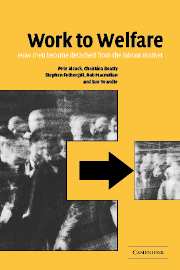Book contents
- Frontmatter
- Contents
- List of figures
- List of tables
- Notes on the authors
- Preface
- List of abbreviations
- Part I The context for labour market detachment
- Part II New evidence from the UK
- 4 The detached male workforce
- 5 Incapacity Benefit and unemployment
- 6 The over 50s
- 7 Family, life course and labour market detachment
- 8 The role of health in labour market detachment
- 9 Getting by
- 10 Back to work?
- Part III The policy implications
- Appendix: Research methodology
- References
- Index
9 - Getting by
Published online by Cambridge University Press: 22 September 2009
- Frontmatter
- Contents
- List of figures
- List of tables
- Notes on the authors
- Preface
- List of abbreviations
- Part I The context for labour market detachment
- Part II New evidence from the UK
- 4 The detached male workforce
- 5 Incapacity Benefit and unemployment
- 6 The over 50s
- 7 Family, life course and labour market detachment
- 8 The role of health in labour market detachment
- 9 Getting by
- 10 Back to work?
- Part III The policy implications
- Appendix: Research methodology
- References
- Index
Summary
Introduction
For most working-age people, earnings constitute the ‘norm’ in terms of making ends meet. This is sometimes supplemented by other sources of income, but individuals and households largely ‘get by’ through earnings from work. Whole societies and economies are arguably predicated on this norm, which has had immense symbolic significance (Bauman 1998) even if it tends to downplay or overlook the role of unpaid work such as domestic labour, unpaid care and voluntary work (Levitas 1998).
For the Labour government in the UK, for example, employment has become a central plank of both economic and social policy. Commentators increasingly refer to an ‘employment-centred’ social policy based on the promotion of work and the work ethic (Jordan 1998, Annesley 2001: 202–18), encapsulated in the now familiar refrain regarding the focus on ‘work for those who can, security for those who cannot’ (Department of Social Security 1998a: iii). Not only does the focus on employment and employability have important economic consequences, it is also suggested to be the most effective ‘escape route’ from low incomes and social exclusion.
In attempting to make employment-centred social policy a reality, policies regarding income maintenance for those of working age have focused upon the introduction and development of a range of in-work benefits. New tax credits for working families, for child care costs, and for employment have been introduced or are in development.
- Type
- Chapter
- Information
- Work to WelfareHow Men Become Detached from the Labour Market, pp. 206 - 227Publisher: Cambridge University PressPrint publication year: 2003

